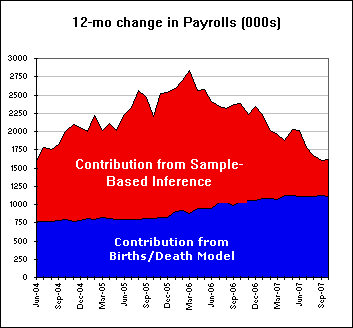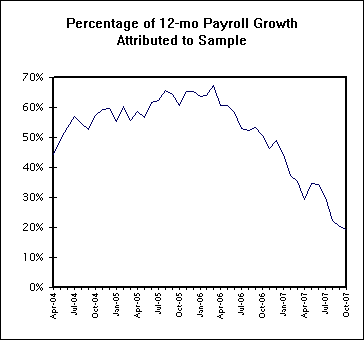Ray Stone of Stone & McCarthy Research Associates has some interesting observations on the quality of the payroll employment numbers released by the Bureau of Labor Statistics.
We’ve noted before some of the strengths and weaknesses of the Bureau of Labor Statistics’ birth/death model. The BLS payroll data come from a count of how many people are working at a surveyed set of business establishments. One inherent problem with such data is how you account for newly created firms that weren’t covered by your survey, and how to distinguish firms that don’t answer the survey from those that have gone out of business. The BLS attempts to estimate the number of births and deaths on the basis of statistical extrapolation of the data that it does observe in what is known as its birth/death model. This approach has its critics and defenders.
One of the even-handed analysts is Ray Stone of Stone & McCarthy Research Associates, whose recent observations (subscription required) include the following:
Over the years we have taken great pains to defend the BLS
Births/Deaths model (BDM) as an appropriate consideration in the
Bureau’s monthly payroll estimate. We have taken exception with a
number of commentators, who have erroneously argued that these are
imaginary jobs, and have provided an inappropriate boost to the
month-to-month payroll numbers….At the same time we recognized the limitations of the BDM. The
most serious limitation of the BDM is that it is a time-series model,
and as such, does not pick up turning points or inflection points.
Some pundits have at times compared the birth/death adjustment (a seasonally unadjusted quantity) to the reported payroll growth (which is seasonally adjusted), which is a highly misleading comparison of apples and oranges. But Ray instead looks at the cumulative change in the seasonally unadjusted employment figures over the last twelve months, and compares these with the cumulative 12-month component that is attributable to the birth/death adjustment.
 |
Reported payroll numbers have been showing slower but still positive payroll growth over the last year. Stone’s calculations imply that most of that growth is coming from the statistical imputation of the birth/death model as opposed to actual data, an imputation that could be particularly suspect if we have indeed been at a turning point, i.e., a period in which business deaths are more common than usual.
 |
It’s not clear what the best thing to do in this situation might be. We know there’s a potential problem with the birth/death adjustment missing a turning point. But the private estimates from
Automatic Data Processing appear to be constructed as a forecast of the BLS payroll numbers, and the separate BLS household survey, though not subject to the same business birth/death problem, have been hopelessly erratic over the last three months, though exhibiting a more pessimistic overall trend than the payroll data.
My conclusion is that the job market is probably not as strong at the moment as the recent BLS payroll data would lead us to believe.
Technorati Tags: macroeconomics,
employment,
economics,
birth/death model
Both yours & their comment are very good.
I would just point out that the household survey has a long history of tending to lead the payroll survey at turning points.
Nice, informative summary, Professor. Thank you.
Professor Hamilton, can you discuss the number of working age citizens versus total population, or population ex-workers over time? I am concerned the ratio of workers:population will become insufficient to sustain GDP growth as baby-boomers retire. Even if retirees take part-time positions to supplement income, they probably won’t add much to GDP. I am also wondering if the currently good employment data is misleading due to fewer people as a percent of the population _looking_ for a job.
Anchoku, I have an old post on some related issues.
If I’m not mistaken, the ADP survey does that larger firms–the type that would be covered under the payroll survey–are shedding jobs, while small businesses are still creating jobs.
Whoops…dropped a word in there. “the ADP survey does say”
Professor, has anyone done a retospective comparison of the B/D model performance in earlier inflection points, both up and down?
BTW, I see the B/D model last month shows net new job GROWTH in both construction and financial services for nine straight months. What are the chances?
We in Minnesota are undergoing an interesting but disturbing phenomenon – job growth below and an unemployment rate above the national numbers. Minnesota has always had a very diverse and healthy economy so this seems particularly unusual. I’m pretty sure the state doesn’t use any type of B/D modeling and I suspect it is quite a bit more accurate than the national models simply because of scale. However it leads me to wonder that if Minnesota’s numbers are correct what might that say about the REAL national numbers? Maybe Minnesota beating itself up over underperformance is unwarranted by comparing to the national numbers, maybe we are actually doing as well or better. Just a thought.
The entire housing sector is unemployed, whether they’re counted, or even whether they know it or not.
Your comments on this topic are always helpful and informative. I am curious about two points.
First, you write, “Stone’s calculations imply that most of that growth is coming from the statistical imputation of the birth/death model as opposed to actual data…”
In the past (I remember, but cannot find the link) you have carefully noted that there was an implicit birth/death model before the recent “adjustment.” The BLS projected their survey results to the entire sampling frame even though they knew that some of the businesses and jobs were gone. This “old method” of dealing with business births and deaths imputes about 2.5 million new jobs each month. The more recent birth/death adjustment is a wisp of foam on top of a giant wave when compared to this assumption.
I believe that it is misleading for Dr. Stone to imply that the old method constitutes actual data. It also had a statistical process, one that has been vastly inferior to the new method. It also would not have been any good at turning points, as we learned.
Given this, I fail to see the logic in comparing the net change in jobs to this particular adjustment. In a slower economy, the monthly growth is small relative to the B/D adjustment, VERY small relative to overall growth, and small relative to the sampling error (CI +/- about 100K). So what?
Second, the BLS says that it monitors the model on a quarterly basis (with a lag, of course, while waiting for state data). Perhaps we will not miss the inevitable turning point by so much.
why “hopelessly erratic ?” If they are anything like other surveys, the sample size is so small that the jumps are entirely consistent with the statistics of small numbers.
So, how MANY households are surveyed ?
Given that changes of 0.2-0.3% are considered significant, then one should survey at least 100,000 homes to get a meaningful statistical uncertainty. If you can’t/won’t, then don’t bother. any result would be swamped by the error.
but again, we are talking about economists, not scientists…
With the computer power available, why can’t the government just tabulate the number of unique social security numbers which show medicare taxes?
dbr
Indeed dbr. Is the concern to publish a palatable number that can be “advanced”, “preliminaried”, “finalized” and then “revised” (perhaps repeatedly) or to give us the information directly and, with those computers, instantly?
The business of statistics –esp marketing that product…is not about to be undone by a real time number from some computer monitoring “employed or not?”.
It reminds me of the altercation of a “difficult” (but ever so learned) witness with an impatient judge who interrupted the testimony by demanding that he just answer the question ‘yes’ or ‘no’ –if his language allowed for that delicate distinction.
Either we prune back the increased power of computers –or the candidness of their use…like the increased transparency of the latest FED meetings …with a suitably delayed report…compiling a suitably agreeable overview.
Steve,
You are right about ADP. ADP data show most of the net growth in employment among small firms, the very sort of firm most likely to be represented on the birth side of the birth/death model. So ADP data suggest the BDM is not entirely whacked out. An interesting exercise would be to compare ADP small firm hiring to the BDM’s small-firm assumptions, but to my knowledge (which may well be faulty), BLS doesn’t publish such details.
Actually, the Business Employment Dynamics (BED) data, which are based on the underlying unemployment records (QCEW data) are broken down by firm size. I have compared these data with the ADP data. The ADP data does an excellent job in the 50 to 499 worker grouping, tends to exhibit an upside bias with the 1 to 49 worker grouping, and tends to exhibit a cyclical pattern of a reduced amplitude in comparison to the BED series for firms in excess of 500 workers. I suspect these observations make sense when you think who ADP’s clients might be. They are less likely to service large manufacturers or retailers such as GM or WalMart. And the ADP sample is less likely to have a representative sample of small firms. The small firms serviced by ADP are not likely to be startups, tiny contractors, etc.